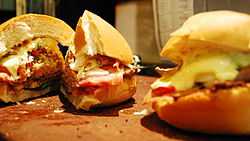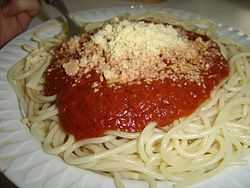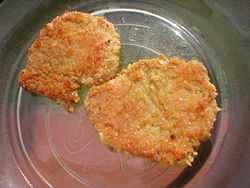Uruguayan cuisine

Uruguayan cuisine is traditionally based on its Indigenous Charrua and European roots, in particular, European food from Italy, Spain, Portugal and France, but also from countries such as Germany and Britain. Many foods from those countries such as pasta, sausages, and desserts are common in the nation's diet. The Uruguayan barbecue, asado, is one of the most exquisite and famous in the world. A sweet paste, dulce de leche, is used to fill cookies, cakes, pancakes, milhojas, and alfajores. The alfajores are shortbread cookies sandwiched together with dulce de leche or a fruit paste. Dulce de leche is used also in flan con dulce de leche.
The national drink is an infusion called mate. The dried leaves and twigs of the yerba mate plant (Ilex paraguariensis) are placed in a small cup. Hot water is then poured into the gourd at near-boiling point so as to not burn the herb and spoil the flavour. The drink is sipped through a metal or cane straw, known as a bombilla.
A traditional drink is Grappamiel, an alcoholic drink which is very popular in rural areas. It is made with alcohol and honey. It is often consumed in the cold mornings of autumn and winter to warm up the body.




- Asado: both the tradition of grilling beef over coals (which translates to barbecue in American English), and the dish, "tira de asado".
- Chivito is a sandwich containing steak, ham, cheese, tomato, lettuce, and mayonnaise.
- Choripán is a very popular Uruguayan fast food: A grilled chorizo and a crusty bread such as a baguette, usually served with chimichurri sauce.
- Empanada: a small pie or turnover, most commonly filled with meat, such as ham and cheese.
- Empanada Gallega: a fish pie, with sauce, onions and bell peppers. Brought by immigrants from Galicia.
- Fainá: a mix of chickpea flour, salt, water and olive oil, originally called "farinata", cooked like a pizza on a flat tray. Brought by immigrants from Liguria (Italy).
- Pancho: the typical Uruguayan hot dog: a bun called "pan de Viena" filled with a "Frankfurter" with mustard, ketchup, mayonnaise or "salsa golf" on top.
- Gnocchi (known as "ñoquis") is traditionally eaten on the 29th day of each month. This was the day before payday, when people were at their poorest. Gnocchi made a cheap and hearty meal. On these occasions, some people leave a coin or a banknote under the plate to attract prosperity.
- Húngara: very similar to the Frankfurter, but very spicy.
- Milanesa: a thin breaded cutlet steak. There is a great variety, such as: Milanesa Napolitana, Milanesa Rellena, and Suprema Maryland.
- Lehmeyun: an Armenian dish, brought by Armenian immigrants.
- Pascualina: a swiss chard pie, puff pastry crust on bottom and top, filled with seasoned swiss chard and eggs, pascualina is a reference to Pascua, 'Easter'.
- Pastel de carne: in English: meat pie. Chopped meat, mashed potato, green peppers, olives, and eggs.
- Russian salad: potatoes, carrots, peas and mayonnaise.
Pizza (locally pronounced pisa or pitsa), for example, has been wholly subsumed and in its Uruguayan form more closely resembles an Italian calzone than it does its Italian ancestor. Typical Uruguayan pizzas include pizza rellena (stuffed pizza), pizza por metro (pizza by the meter), and pizza a la parrilla (grilled pizza). While Uruguayan pizza derives from Neapolitan cuisine, the Uruguayan fugaza/fugazza comes from the focaccia xeneise (Genoan), but in any case its preparation is different from its Italian counterpart, and the addition of cheese to make the dish (fugaza con queso or fugazzeta) is an Uruguayan invention.
Fainá is a type of thin bread made with chickpea flour (adopted from northern Italy). During the 20th century, people in pizzerias in Montevideo commonly ordered a "combo" of moscato, pizza, and fainá, which is a large glass of a sweet wine called moscato (muscat), plus two stacked pieces (the lower one being pizza and the upper one fainá). Despite both pizza and faina being Italian in origin, they are never served together in that country.
Nevertheless, the pastas (pasta, always in the plural) surpass pizzas in consumption levels. Among them are tallarines (fettuccine), ravioles (ravioli), ñoquis (gnocchi), and canelones (cannelloni). They are usually cooked, served, and consumed in Uruguayan fashion, called al-uso-nostro, a phrase of Italian origin.
Sliced pizza served over fainá is a common combination. For example, it is common for pasta to be eaten together with white bread ("French bread"), which is unusual in Italy. This can be explained by the low cost of bread and that Uruguayan pasta tends to come together with a large amount of tuco sauce (Italian suco "juice"), and accompanied by estofado (stew). Less commonly, pastas are eaten with a sauce of pesto, a green sauce based on basil, or salsa blanca (Béchamel sauce).
Polenta comes from Northern Italy and is very common throughout Uruguay. But unlike in Italy, this cornmeal is eaten as a main dish, with sauce and melted cheese.
Spanish influences are very abundant: desserts like the churros (cylinders of pastry, usually fried, sometimes filled with dulce de leche), flan, ensaimadas (Catalan sweet bread), and alfajores are all descended from Spain. Nearly all kinds of stews known as "guisos" or "estofados", arroces (rice dishes such as paella), and fabada (Asturian bean stew). All of the guisos and pucheros (stews) are of Spanish origin. Uruguayan preparations of fish, such as dried salt cod (bacalao), calamari, and octopus, originate from the Basque and Galician regions, and also Portugal.
Germanic influence has impacted Uruguayan food as well, particularly sweet dishes. The pastries known as bizcochos are Germanic in origin: croissants, known as medialunas, are the most popular of these, and can be found in two varieties: butter- and lard-based. Also German in origin are the Berlinese known as bolas de fraile ("friar's balls"), and the rolls called piononos. The facturas were re-christened with local names given the difficult phonology of German, and usually Uruguayanized by the addition of a dulce de leche filling. In addition, dishes like chucrut (sauerkraut) have also made it into mainstream Uruguayan cuisine.
Due to its strong Italian tradition, in Uruguay all of the famous Italian pasta dishes are present: ravioli, spaghetti, lasagne, tortellini, fettuccine, cannelloni, fusilli, agnolotti, tagliatelle, capellini, vermicelli, penne rigatti, fagioloni, cellentani, rotini, bucatini, farfalle, and the traditional gnocchi. Although the pasta can be served with a lot of sauces, there is one special sauce that was created by Uruguayans. The Caruso Sauce is a pasta sauce made from double cream, meat extract, onions, ham and mushrooms. It is very popular with sorrentinos and agnolotti.
Desserts
Cakes

- Schwarzwälder Kirschtorte: brought by immigrants from Germany, consists of several layers of chocolate cake, with whipped cream and cherries between each layer (Selva Negra).
- Chajá: a dessert with meringue, sponge cake, "Chajá" cream and peaches. It is created by a well known firm in the city of Paysandú.[1]
- Génoise cake: Italian sponge cake served with buttercream frosting, brought by the Italian immigrants (Plantillas).
- Frankfurter Kranz: shaped like a crown in a ring shape, it is filled with buttercream (and also possibly jam or jelly) and topped with caramel-covered brittle nuts, called Krokant. Brought by the German immigrants from Frankfurt am Main. Mainly eaten during holidays and very popular among Uruguayan desserts (Almendrado).
- Prinzregententorte: a cake that consists of at least six thin layers of sponge cake interlaid with chocolate buttercream, the exterior is covered in a dark chocolate glaze. Brought by the German immigrants from Bavaria.
- Isla Flotante, made with egg white and sugar, and served with zabaione.
Confectioneries
- Garrapiñada: a very popular treat, made with peanuts covered with cocoa, vanilla and sugar, resembling whole-nut pralines. It is sold in little bags in the downtown's streets.
- Damasquitos: Jelly apricot candies.
- Yemas acarameladas: Egg candy made mainly with egg yolks, vanilla and sugar. It has a spherical shape of about one inch diameter, and covered with a thin layer of hard, transparent, caramelized sugar coating.
- Zapallo en almíbar: Squash in syrup.
Cookies
- Alfajores: longbread cookies, sandwiched together with Dulce de Leche (caramelized milk) or a fruit paste.
- Yo-yo: Layered pastry filled with Dulce de Leche and coated with chocolate on the upper half. It is shaped like a yo-yo.
- Churros: came from Spain, and are just like those, except some have fillings, like custard cream or Dulce de Leche.
Custards and ice creams

- Dulce de leche: a sweet treat made of milk and sugar. It is used in many Uruguayan desserts.
- Gelato: an Italian variant of ice-cream, flavored with fresh fruit purees, cocoa or nut pastes. If other ingredients such as chocolate flakes, nuts, small confections, cookies, or biscuits are added, they are added after the gelato is frozen. Gelato made with fresh fruit sugar, water, and without dairy ingredients is known as sorbet. Brought by the Italian immigrants.
- Dulce de membrillo: a sweet quince jelly-like preserve.
- Budín inglés: in English: "English pudding". A pudding with fruits and nuts, very popular in Christmas and New Year's Eve.
- Flan: a kind of rich custard dessert with a layer of soft caramel on top. It can be served with Dulce de Leche too (Flan con dulce de leche).
- Martín Fierro: a slice of cheese and a slice of quince preserve (dulce de membrillo).
- Ricardito: Also as popular, this is a cream filled treat, covered with chocolate on a waffle base. It has different variants and it's sold in most kiosks in individual boxes.
- Granita: a semi-frozen dessert of sugar, water, and flavorings originally brought from the Italian immigrants from Sicily.
- Semifreddo: a class of semi-frozen desserts, typically ice-cream cakes, semi-frozen custards, and certain fruit tarts. It has the texture of frozen mousse because it is usually produced by uniting two equal parts of ice cream and whipped cream, brought by the Italian immigrants from Northern Italy.
- Crème caramel: a rich custard dessert with a layer of soft caramel on top, as opposed to crème brûlée, which is custard with a hard caramel top. Brought by the immigrants from France and Spain.
Pastries


- Bizcochos: buttery flaky pastry with many variants, the croissants being one of the most popular.
- Strudel: the famous apple pie from Germany.
- Pastafrola: an exquisite pie made of quince paste (dulce de membrillo).
- Crêpes: brought by the immigrants from France, popular for a typical Uruguayan breakfast. When sweet, they can be eaten for dessert. They can be filled with various sweet toppings, often including Nutella, sugar (granulated or powdered), maple syrup, lemon juice, whipped cream, fruit spreads, custard, and sliced soft fruits. The most popular are Apple Crepes and Dulce de Leche Crepes.
- Loukoumades: a kind of fried-dough pastry made of deep fried dough soaked in sugar syrup, honey or cinnamon, and sometimes sprinkled with sesame, brought by the Greek immigrants.
See also
References
External links
| Wikimedia Commons has media related to Cuisine of Uruguay. |
| ||||||||||
| ||||||||||||||||||||||||||||||||||||||||||||||||||||||
